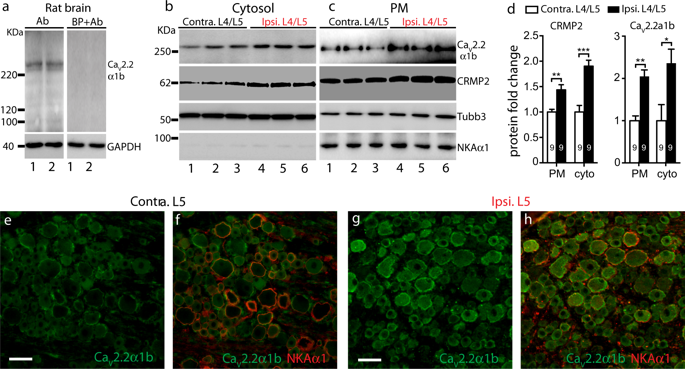当前位置:
X-MOL 学术
›
Gene Ther.
›
论文详情
Our official English website, www.x-mol.net, welcomes your feedback! (Note: you will need to create a separate account there.)
AAV-encoded CaV2.2 peptide aptamer CBD3A6K for primary sensory neuron-targeted treatment of established neuropathic pain.
Gene Therapy ( IF 5.1 ) Pub Date : 2019-05-22 , DOI: 10.1038/s41434-019-0082-7 Hongwei Yu 1, 2 , Seung Min Shin 1, 2 , Hongfei Xiang 1, 3 , Dongman Chao 1 , Yongsong Cai 1, 4 , Hao Xu 1, 3 , Rajesh Khanna 5 , Bin Pan 1 , Quinn H Hogan 1, 2
Gene Therapy ( IF 5.1 ) Pub Date : 2019-05-22 , DOI: 10.1038/s41434-019-0082-7 Hongwei Yu 1, 2 , Seung Min Shin 1, 2 , Hongfei Xiang 1, 3 , Dongman Chao 1 , Yongsong Cai 1, 4 , Hao Xu 1, 3 , Rajesh Khanna 5 , Bin Pan 1 , Quinn H Hogan 1, 2
Affiliation

|
Transmission of pain signals from primary sensory neurons to secondary neurons of the central nervous system is critically dependent on presynaptic voltage-gated calcium channels. Calcium channel-binding domain 3 (CBD3), derived from the collapsin response mediator protein 2 (CRMP2), is a peptide aptamer that is effective in blocking N-type voltage-gated calcium channel (CaV2.2) activity. We previously reported that recombinant adeno-associated virus (AAV)-mediated restricted expression of CBD3 affixed to enhanced green fluorescent protein (EGFP) in primary sensory neurons prevents the development of cutaneous mechanical hypersensitivity in a rat neuropathic pain model. In this study, we tested whether this strategy is effective in treating established pain. We constructed AAV6-EGFP-CBD3A6K (AAV6-CBD3A6K) expressing a fluorescent CBD3A6K (replacing A to K at position 6 of CBD3 peptide), which is an optimized variant of the parental CBD3 peptide that is a more potent blocker of CaV2.2. Delivery of AAV6-CBD3A6K into lumbar (L) 4 and 5 dorsal root ganglia (DRG) of rats 2 weeks following tibial nerve injury (TNI) induced transgene expression in neurons of these DRG and their axonal projections, accompanied by attenuation of pain behavior. We additionally observed that the increased CaV2.2α1b immunoreactivity in the ipsilateral spinal cord dorsal horn and DRG following TNI was significantly normalized by AAV6-CBD3A6K treatment. Finally, the increased neuronal activity in the ipsilateral dorsal horn that developed after TNI was reduced by AAV6-CBD3A6K treatment. Collectively, these results indicate that DRG-restricted AAV6 delivery of CBD3A6K is an effective analgesic molecular strategy for the treatment of established neuropathic pain.
中文翻译:

AAV 编码的 CaV2.2 肽适体 CBD3A6K,用于对已建立的神经性疼痛进行初级感觉神经元靶向治疗。
疼痛信号从初级感觉神经元到中枢神经系统次级神经元的传输严重依赖于突触前电压门控钙通道。钙通道结合域 3 (CBD3) 源自崩溃蛋白反应介质蛋白 2 (CRMP2),是一种肽适体,可有效阻断 N 型电压门控钙通道 (CaV2.2) 活性。我们之前曾报道过,重组腺相关病毒 (AAV) 介导的 CBD3 限制性表达,附着在初级感觉神经元中的增强型绿色荧光蛋白 (EGFP) 上,可防止大鼠神经性疼痛模型中皮肤机械超敏反应的发展。在这项研究中,我们测试了这种策略是否对治疗既定的疼痛有效。我们构建了 AAV6-EGFP-CBD3A6K (AAV6-CBD3A6K),表达荧光 CBD3A6K(将 CBD3 肽的第 6 位的 A 替换为 K),这是亲本 CBD3 肽的优化变体,是更有效的 CaV2.2 阻断剂。在胫神经损伤 (TNI) 后 2 周,将 AAV6-CBD3A6K 递送到大鼠的腰椎 (L) 4 和 5 背根神经节 (DRG),诱导这些 DRG 及其轴突投射的神经元中的转基因表达,伴随着疼痛行为的减弱。我们还观察到,TNI 后同侧脊髓背角和 DRG 中增加的 CaV2.2α1b 免疫反应性通过 AAV6-CBD3A6K 治疗显着正常化。最后,AAV6-CBD3A6K 治疗降低了 TNI 后同侧背角神经元活动的增加。总的来说,
更新日期:2019-11-18
中文翻译:

AAV 编码的 CaV2.2 肽适体 CBD3A6K,用于对已建立的神经性疼痛进行初级感觉神经元靶向治疗。
疼痛信号从初级感觉神经元到中枢神经系统次级神经元的传输严重依赖于突触前电压门控钙通道。钙通道结合域 3 (CBD3) 源自崩溃蛋白反应介质蛋白 2 (CRMP2),是一种肽适体,可有效阻断 N 型电压门控钙通道 (CaV2.2) 活性。我们之前曾报道过,重组腺相关病毒 (AAV) 介导的 CBD3 限制性表达,附着在初级感觉神经元中的增强型绿色荧光蛋白 (EGFP) 上,可防止大鼠神经性疼痛模型中皮肤机械超敏反应的发展。在这项研究中,我们测试了这种策略是否对治疗既定的疼痛有效。我们构建了 AAV6-EGFP-CBD3A6K (AAV6-CBD3A6K),表达荧光 CBD3A6K(将 CBD3 肽的第 6 位的 A 替换为 K),这是亲本 CBD3 肽的优化变体,是更有效的 CaV2.2 阻断剂。在胫神经损伤 (TNI) 后 2 周,将 AAV6-CBD3A6K 递送到大鼠的腰椎 (L) 4 和 5 背根神经节 (DRG),诱导这些 DRG 及其轴突投射的神经元中的转基因表达,伴随着疼痛行为的减弱。我们还观察到,TNI 后同侧脊髓背角和 DRG 中增加的 CaV2.2α1b 免疫反应性通过 AAV6-CBD3A6K 治疗显着正常化。最后,AAV6-CBD3A6K 治疗降低了 TNI 后同侧背角神经元活动的增加。总的来说,



























 京公网安备 11010802027423号
京公网安备 11010802027423号